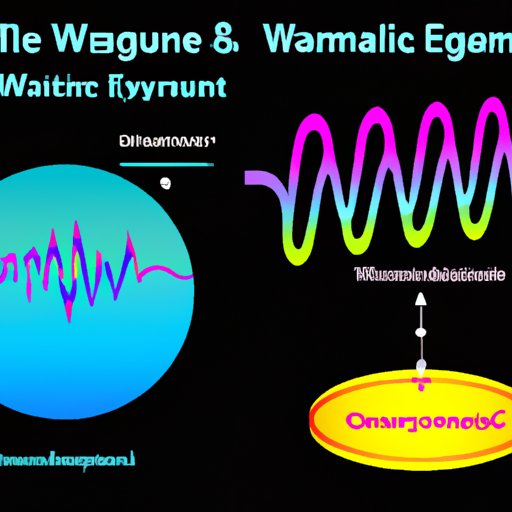What is the Shortest Wavelength Electromagnetic Wave?
Electromagnetic waves are an essential aspect of the universe we live in. Electromagnetic waves are defined as the way energy travels through different mediums. Understanding electromagnetic waves and their wavelengths is crucial for various fields, including physics, medicine, and communication. The classification of these waves by their wavelengths is also important to identify different electromagnetic phenomena. In this article, we will explore the electromagnetic wave with the shortest wavelength, its properties, and its implications.
The Shortest Wavelength Electromagnetic Wave
There are various types of electromagnetic waves, including radio waves, microwaves, infrared radiation, visible light, ultraviolet radiation, X-rays, and gamma rays. Each of these waves has different wavelengths and properties. The wavelength of a wave refers to the distance between the peak of each wave or the trough of each wave.
The electromagnetic wave with the shortest wavelength is the gamma ray. Gamma rays have wavelengths that range from 0.01 to 0.1 nanometers. To put this in perspective, the thickness of a sheet of paper is about 100,000 nanometers thick! Gamma rays are the highest energy form of electromagnetic radiation and are produced by nuclear reactions and other subatomic particle processes.
The highest energy of gamma rays means that they have the most significant potential for destruction or damage. Gamma rays can penetrate through a broad range of materials, including concrete, steel, and even human tissue. Gamma rays can cause severe damage to living cells, including DNA mutations that can lead to cancer. They also have implications in nuclear physics, where they are used in radiation therapy and cancer treatment.
Comparison of Different Electromagnetic Waves
Now that we have identified the electromagnetic wave with the shortest wavelength let’s compare it to the other types of electromagnetic waves.
The electromagnetic spectrum is the range of all electromagnetic waves, and it is divided into seven different categories, including radio, microwave, infrared, visible light, ultraviolet, X-rays, and gamma rays. Radio waves have the longest wavelengths, and gamma rays have the shortest wavelengths.
Radio waves are used for communication, including television and radio broadcasting. Microwaves are used for communication, including satellite and cell phone communication and for cooking food. Infrared radiation can be felt as heat and can be used for remote controls, heat lamps, and in thermal imaging cameras. Visible light is responsible for what we see in the natural world and can be divided into different colors based on their wavelengths. Ultraviolet radiation is known for its ability to cause skin damage and sunburn and is also responsible for causing fluorescent material to glow. X-rays use high energy to penetrate materials and are used in medical imaging. Gamma rays are the highest energy forms of radiation and are produced by nuclear reactions.
The unique properties of gamma rays are their high energy and short wavelengths, which make them the most damaging forms of radiation. Gamma rays can kill cells within the body and are used in cancer treatments to target cancerous cells.
The Electromagnetic Spectrum
What is the electromagnetic spectrum? The electromagnetic spectrum is a way of organizing electromagnetic radiation based on wavelength. The spectrum is divided into seven regions, radio waves, microwaves, infrared, visible light, ultraviolet radiation, X-rays, and gamma rays.
Radio waves have the longest wavelengths and the lowest energy. Gamma rays have the shortest wavelengths and the highest energy. The wavelengths of electromagnetic radiation range from very long wavelengths, such as the radio waves used in communication, to very short wavelengths, such as the gamma rays used in medical treatments and nuclear energy.
The wavelength with the smallest length is gamma radiation. Gamma radiation wavelengths range from 0.01-0.1 nanometers.
Importance of Wavelength
Understanding the different wavelengths of electromagnetic radiation is important because each kind of wave interacts with the world differently. For example, radio waves are used for communication, microwave radiation is used for cooking food, and visible light allows us to see the world around us.
Longer wavelengths of radiation are useful in communication because they can pass through buildings and other materials with ease. Shorter wavelengths are highly damaging to living organisms and are used in cancer treatments to target and kill cancer cells.
Shorter wavelengths of radiation, including ultraviolet radiation and X-rays, can damage living tissue and cause health problems. However, shorter wavelengths also have the potential to do good. For example, ultraviolet radiation can sterilize equipment and surfaces, making them a useful tool in medical settings.
The Impact of Electromagnetic Radiation on Living Organisms
Shorter wavelengths of radiation, including X-rays and gamma rays, can have severe health consequences for living organisms. It is well-known that exposure to electromagnetic radiation can cause health problems, including cancer and other diseases.
Although many studies have shown the negative effects of electromagnetic radiation on living organisms, some studies have also shown positive effects. For example, research has shown that ultraviolet radiation can be used as a means of sterilization and disinfectant.
The use of electromagnetic radiation in medical treatments, such as radiation therapy, can be highly effective and can save lives. However, it is essential to understand the risks involved in the use of electromagnetic radiation and to ensure that the risks are carefully monitored and minimized.
Conclusion
Understanding the different types of electromagnetic waves and their wavelengths is crucial in understanding the world around us. The shortest wavelength electromagnetic wave, the gamma ray, has important properties and implications for medicine, nuclear physics, and other fields. It is important to be aware of the potential damage that radiation from shorter wavelengths can cause and to take steps to minimize exposure whenever possible.
The electromagnetic spectrum is fascinating, and we have only just begun to explore its potential uses. Further research into the different types of electromagnetic radiation and their properties will undoubtedly lead to new discoveries and advancements in science and technology.
